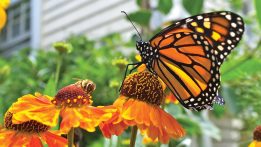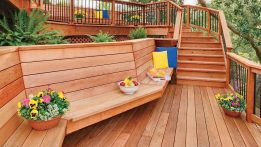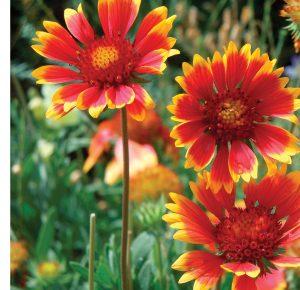 Florida’s abundant lakes, springs, and rivers make it easy to overlook that water is a finite and fragile resource. The job of protecting water starts at home, where its biggest use is often for lawns and gardens. It’s important to realize that water used for landscaping or from rainfall doesn’t stay on our property for long. Excess rain or irrigation empties into storm drains and in the process transports fertilizers, pesticides, pet waste, silt and other contaminants. In some soils it can reach groundwater, the source of 90 percent of Florida’s drinking water.
Florida’s abundant lakes, springs, and rivers make it easy to overlook that water is a finite and fragile resource. The job of protecting water starts at home, where its biggest use is often for lawns and gardens. It’s important to realize that water used for landscaping or from rainfall doesn’t stay on our property for long. Excess rain or irrigation empties into storm drains and in the process transports fertilizers, pesticides, pet waste, silt and other contaminants. In some soils it can reach groundwater, the source of 90 percent of Florida’s drinking water.
Using the nine research-based principles of Florida-Friendly LandscapingTM can help you create a yard that protects and conserves water, attracts wildlife, and reflects the state’s natural beauty. The Florida-Friendly LandscapingTM Program is a joint venture of the Florida Department of Environmental Protection and the University of Florida Institute of Food and Agricultural Sciences that provides free public education and training statewide. The program works with state Water Management Districts and other organizations to conserve and protect Florida’s natural resources.
Right plant, right place
A plant placed in the right spot won’t need a lot of water, fertilizers, pesticides or pruning. Consider an area’s soil, light, and water conditions and then select plants to match those conditions. You can obtain a free copy of The Florida-Friendly Landscaping™ Guide to Plant Selection & Landscape Design from your local UF-IFAS County Extension Service office or download it from http://fyn.ifas.ufl.edu/homeowner.htm. The book shows over 500 Florida-Friendly plants in full color with critical information and plant characteristics you need to select the right plant for the right place. You can pick up a free copy of The Florida Yards and Neighborhoods Handbook from the same locations.
Water efficiently
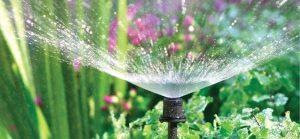 Overwatering a landscape taxes the water supply and makes plants prone to pests. A well-planned and operated irrigation system can reduce water bills and the chances of insect and disease problems.
Overwatering a landscape taxes the water supply and makes plants prone to pests. A well-planned and operated irrigation system can reduce water bills and the chances of insect and disease problems.
Plant beds are a good spot for drip or micro-spray systems, which are more efficient than regular spray heads. These should be on a separate zone from turfgrass sprinklers. Watch for signs of wilt before watering. Adjust sprinklers so they don’t water paved surfaces and don’t water in the heat of the day. Early morning is best. Do not water if it has rained in the past 24 hours or if rain is forecast in the next 24 hours. Even an efficient irrigation system can waste water. Make sure the irrigation system is calibrated.
Fertilize appropriately
 A properly fertilized, healthy lawn filters out impurities, stabilizes the soil and promotes a healthy ecosystem. Over-fertilizing stimulates excessive growth and invites pest problems. Read fertilizer package labels carefully and use fertilizer only when necessary and as directed. Apply fertilizer when grass is actively growing. Do not fertilize during the cooler season because grass goes dormant. Fertilizer not absorbed by plant roots can wash into storm drains or leach into the soil. Unused nutrients from fertilizers that reach surface waterways can harm aquatic life and promote algal blooms. Never fertilize within 10 feet of any water body or before a heavy rain.
A properly fertilized, healthy lawn filters out impurities, stabilizes the soil and promotes a healthy ecosystem. Over-fertilizing stimulates excessive growth and invites pest problems. Read fertilizer package labels carefully and use fertilizer only when necessary and as directed. Apply fertilizer when grass is actively growing. Do not fertilize during the cooler season because grass goes dormant. Fertilizer not absorbed by plant roots can wash into storm drains or leach into the soil. Unused nutrients from fertilizers that reach surface waterways can harm aquatic life and promote algal blooms. Never fertilize within 10 feet of any water body or before a heavy rain.
Mulch
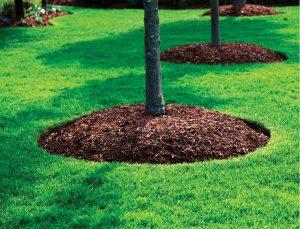 Among its many benefits, mulch retains soil moisture, inhibits weeds and adds visual appeal. Grass replaced with mulch in shady spots or hard-to-reach areas will reduce mowing time. Concerning thickness, a 2-3 inch layer of mulch is best. Pull back mulch several inches from a plant base or tree trunk so disease doesn’t develop. Mulch that is too deep or mounded can damage shrubs and trees. Organic mulch materials, such as bark or pine straw, enrich the soil as they decompose. Fallen leaves under a tree will create self-mulching areas.
Among its many benefits, mulch retains soil moisture, inhibits weeds and adds visual appeal. Grass replaced with mulch in shady spots or hard-to-reach areas will reduce mowing time. Concerning thickness, a 2-3 inch layer of mulch is best. Pull back mulch several inches from a plant base or tree trunk so disease doesn’t develop. Mulch that is too deep or mounded can damage shrubs and trees. Organic mulch materials, such as bark or pine straw, enrich the soil as they decompose. Fallen leaves under a tree will create self-mulching areas.
Attract wildlife
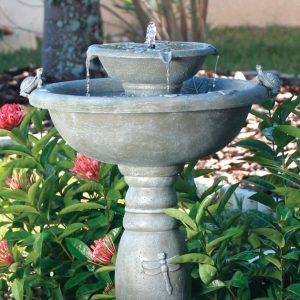 Create a haven for birds, butterflies and beneficial insects by providing food, water, and cover. Select plants with seeds, fruits, berries, foliage or flowers that birds, butterflies and caterpillars can eat. A mix of plants, vines, and shrubs creates cover and nesting areas. Provide water with a pond, fountain, or birdbath. Protect your visitors by limiting the use of pesticides, which reduce an important food source for birds. If cats roam the yard, it’s best not to attract birds and other animals.
Create a haven for birds, butterflies and beneficial insects by providing food, water, and cover. Select plants with seeds, fruits, berries, foliage or flowers that birds, butterflies and caterpillars can eat. A mix of plants, vines, and shrubs creates cover and nesting areas. Provide water with a pond, fountain, or birdbath. Protect your visitors by limiting the use of pesticides, which reduce an important food source for birds. If cats roam the yard, it’s best not to attract birds and other animals.
Manage yard pests responsibly
 Managing insects with the least chemicals possible helps protect both human and environmental health. Start by choosing disease and pest resistant plants well suited to your yard. Also, be sure to use a light hand in the garden. Too much water and fertilizer makes plants vulnerable to problems just as severe pruning can weaken the defenses of a tree or shrub. When problems arise, remove the affected plant parts or pick off the insects by hand. Avoid broad-spectrum pesticides, which can kill beneficial insects, and treat only the affected areas. Use insecticidal soaps and horticultural oils when possible.
Managing insects with the least chemicals possible helps protect both human and environmental health. Start by choosing disease and pest resistant plants well suited to your yard. Also, be sure to use a light hand in the garden. Too much water and fertilizer makes plants vulnerable to problems just as severe pruning can weaken the defenses of a tree or shrub. When problems arise, remove the affected plant parts or pick off the insects by hand. Avoid broad-spectrum pesticides, which can kill beneficial insects, and treat only the affected areas. Use insecticidal soaps and horticultural oils when possible.
Recycle yard waste
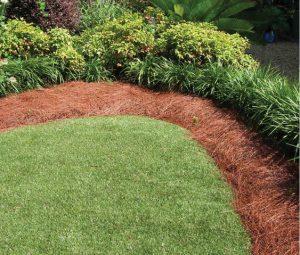 When pine needles, leaves, and other yard waste decompose, they release nutrients back into the soil in a form plants can easily use. Start by leaving grass clippings on the lawn to recycle nitrogen. Use fallen leaves and pine needles as mulch. After pruning trees and shrubs, toss small cuttings into a hidden spot or compost pile. Build or buy a compost bin and use it to mix yard waste with eggshells, teabags and other kitchen scraps—but no animal products. Added to soil, this nutrient-rich compost will improve fertility, texture, and water holding capacity.
When pine needles, leaves, and other yard waste decompose, they release nutrients back into the soil in a form plants can easily use. Start by leaving grass clippings on the lawn to recycle nitrogen. Use fallen leaves and pine needles as mulch. After pruning trees and shrubs, toss small cuttings into a hidden spot or compost pile. Build or buy a compost bin and use it to mix yard waste with eggshells, teabags and other kitchen scraps—but no animal products. Added to soil, this nutrient-rich compost will improve fertility, texture, and water holding capacity.
Reduce stormwater runoff
 When a yard captures water and allows it to filter through the ground, the result is reduced stormwater runoff. Use bricks, gravel, or other porous materials for walkways, patios and driveways. Direct rain gutters and downspouts away from paved surfaces. If possible, contour property to reduce slopes and provide areas where water can pool. Some spots where rainfall collects are perfect for rain gardens planted with wildflowers and other vegetation. Also, pick up trash in your yard, gutters, and street to prevent trash from ending up in storm drains.
When a yard captures water and allows it to filter through the ground, the result is reduced stormwater runoff. Use bricks, gravel, or other porous materials for walkways, patios and driveways. Direct rain gutters and downspouts away from paved surfaces. If possible, contour property to reduce slopes and provide areas where water can pool. Some spots where rainfall collects are perfect for rain gardens planted with wildflowers and other vegetation. Also, pick up trash in your yard, gutters, and street to prevent trash from ending up in storm drains.
Protect the waterfront
As a property owner, you can protect your patch of waterfront. Start by establishing a 10-30 foot maintenance-free zone along the water where you don’t mow or use any lawn chemicals. Keep yard debris and pet waste out of the area. A buffer zone of low maintenance plants will help prevent erosion and provide shelter for wildlife.
Want to know more?
Visit http://fyn.ifas.ufl.edu or contact the Leon County Extension Service at 606-5200. ![]()
By Susan Beason,
Florida Department of Environmental Protection



